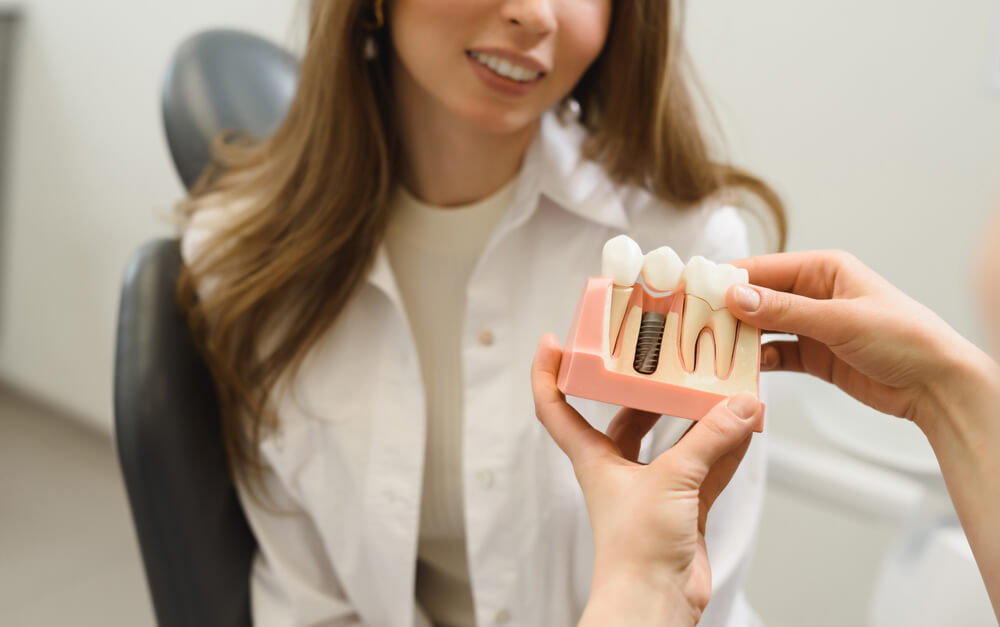Dental implants are a form of cosmetic dentistry that replaces missing teeth. They are usually made from titanium screws surgically implanted into the jawbone. In some cases, the implant may need to be augmented by a bone graft to securely hold it in place. For a dental implant, bone graft is sometimes required. This article will explore what a bone graft is and how it helps with dental implants.
What is a Bone Graft?
A bone graft is a surgical procedure that involves taking small pieces of bone from another part of your body and using them to replace missing or damaged tissue in the jawbone. This process aims to create an environment where dental implants can be securely placed and held in place for years. If there’s not enough bone, the dental implant cannot attach to the jaw and will either fail or not last as long as it should. You will need bone grafting if the jaw is too thin (narrow), short (height), or insufficient around important vital structures (like nerves or sinus cavities) to create a solid foundation for your new dental implant. Bone grafts can also help improve the stability of other dental procedures, such as bridges and crowns, which rely on having strong foundation support.

A bone graft for dental implants could be pieces of your own bone (which will often come from your chin, the back of your lower jaw, or your shin or hip). If there is insufficient bone in these areas, animal (cow or pig) or freeze-dried human bone may be used. Synthetic bone graft materials are also often used, meaning that rejection risks are lower; these materials will also be of interest to vegans and patients with religious beliefs, excluding the use of animal by-products.
Why Would I Need a Bone Graft?
Unfortunately, bone resorption (the thinning, weakening, and deterioration of the bone) is a common side effect of tooth loss and can affect patients of all ages. For an implant to be successful, whether done here or abroad, there must be enough existing jawbone structure to support it. If there is not enough structure present, your dentist may recommend a bone graft to augment the area. This will involve taking small pieces of healthy bone from donor sites such as your hip or lower leg and transplanting them into the jawbone near the implant site. Once healed, this new tissue will add additional volume and strength to support the implant safely.
What Does The Surgery Involve?

The surgical plan then becomes the basis for accurate treatment quotations and, most importantly, reduced operating time, fewer complications, and a faster recovery for the patient.
These are two common scenarios that may require bone grafting:
Replacing one or two teeth with implants
Most commonly, one or two teeth are replaced with implants. In this situation, the treatment stages are:
- Tooth removal + immediate implant placement + bone grafting – The bone graft volume is small, and the space around the implant (where the tooth root once was) is filled with sterile, synthetic, or demineralised human bone granules, then covered with protective collagen membrane and stitched together. Over the next few months, the bone graft will heal and integrate with the surrounding bone tissue, preserving the bone height enough to support the dental implant. To ensure the best result, many Specialist Surgeons will use a platelet-rich blood product (Platelet-Rich Fibrin / Platelet-Rich Plasma) to mix with the bone graft, thus reducing the risk of wound infection and speeding the healing process.
- Implant integration testing – 3 months after implant placement.
- Implant crown (tooth portion) placement – 1 month after implant testing.
Replacing multiple missing teeth with implants
Patients who have had multiple missing teeth for a longer period (many years) often experience advanced bone loss. In this case, extensive bone grafting may be necessary to restore the bone. Your implant surgeon has developed skills to enable the placement of blocks of bone graft material (often fixed in place with plates and screws) to reconstruct large bone defects. Typically the bone graft will be a combination of products, each of different consistency- autologous (from the patient’s jaws, hard palate, or hip), combined with human origin (cadaveric), and synthetic products to completely fill in any gaps.
Finally, your surgeon will put a layer of collagen membranes and PRF or PRP to cover the bone graft material before closing the wound using stitches. After 3-4 months of healing, the bone graft is healed enough to allow the placement of implants.
They will then clean any debris out before inserting synthetic material (allograft) or donor material (autograft). Depending on how much space needs filling, they may also need to perform more than one harvest operation to restore enough mass at once – so patients should expect repeat appointments if this is necessary.
After all the preparation has been done, it’s time for the second visit: when your dentist takes their harvested portions (which have had their own healing period completed beforehand) – along with any necessary equipment – and prepares them for placement at the desired location on jawbone before using specialised tools called osteotomes (used for manipulation) securing them with adhesive cement or screws/plates where appropriate.
Lastly, after everything has been put into place correctly, natural healing must take place over time before the patient returns to the final appointment for a confirmed check-up.
What are the advantages of dental bone grafts?
Dental bone grafts can increase your eligibility for dental implants and other restorative treatments. This procedure restores your jaw to its original form following trauma, tooth loss, or gum (periodontal) disease.
What are the risks or complications of dental bone grafts?

- Infection.
- Heavy bleeding.
- Nerve damage.
- Complications from anesthesia.
How long does it take to recover from a dental bone graft?
Though you will probably feel back to normal within a week or two, complete dental bone graft healing can take between three and nine months – sometimes longer. Recovery times depend on several factors, including the type of graft, the area in which the graft was placed, and your body’s healing capacity.
When can I go back to work or school?
In most cases, people can return to work or school the day after the procedure. If you choose sedation, you may need to take an extra day or two to recover at home.
What are the dental bone graft healing stages?
As mentioned above, recovery times can vary significantly for each person. Once the bone graft is placed, your dentist will monitor your healing. If you’re waiting to undergo dental implant surgery, they will let you know when your new bone is strong enough to support the implant.
Conclusion
Overall, undergoing surgery before dental implants remains still a viable option for those who find themselves lacking sufficient skeletal density area lips up proper placement fixture needed ultimately give the greatest chance success line overall restoration process lasts a lifetime. Call our Sydney CBD clinic today if you need more information.
References:
https://my.clevelandclinic.org/health/treatments/21727-dental-bone-graft
https://www.cuh.nhs.uk/patient-information/bone-grafting-for-dental-implants/
https://www.mayoclinic.org/tests-procedures/dental-implant-surgery/about/pac-20384622
https://www.healthline.com/health/dental-bone-graft






